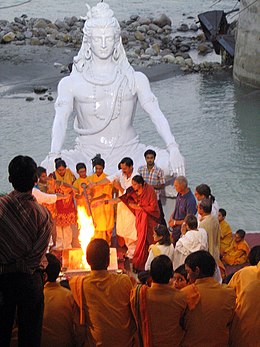
Back Shaivisme Afrikaans شيفاوية Arabic شيفيه ARZ Shivaísmu AST Shaivismo BCL Шываізм Byelorussian Шиваизъм Bulgarian शैव मत Bihari শৈবধর্ম Bengali/Bangla Xivaisme Catalan
 |
| Part of a series on |
| Shaivism |
|---|
 |
|
|
| Part of a series on |
| Hinduism |
|---|
 |
Shaivism (/ˈʃaɪvɪzəm/; Sanskrit: शैवसम्प्रदायः, romanized: Śaivasampradāyaḥ) is one of the major Hindu traditions, which worships Shiva[1][2][3] as the Supreme Being. One of the largest Hindu denominations,[4][5] it incorporates many sub-traditions ranging from devotional dualistic theism such as Shaiva Siddhanta to yoga-orientated monistic non-theism such as Kashmiri Shaivism.[6][7][8] It considers both the Vedas and the Agama texts as important sources of theology.[9][10][11] According to a 2010 estimate by Johnson and Grim, Shaivism is the second-largest Hindu sect, constituting about 253 million or 26.6% of Hindus.[4][12]
Shaivism developed as an amalgam of pre-Vedic religions and traditions derived from the southern Tamil Shaiva Siddhanta traditions and philosophies, which were assimilated in the non-Vedic Shiva-tradition.[13] In the process of Sanskritisation and the formation of Hinduism, starting in the last centuries BCE, these pre-Vedic traditions became aligned with the Vedic deity Rudra and other Vedic deities, incorporating the non-Vedic Shiva-traditions into the Vedic-Brahmanical fold.[2][14]
Both devotional and monistic Shaivism became popular in the 1st millennium CE, rapidly becoming the dominant religious tradition of many Hindu kingdoms.[2] It arrived in Southeast Asia shortly thereafter, leading to the construction of thousands of Shaiva temples on the islands of Indonesia as well as Cambodia and Vietnam, co-evolving with Buddhism in these regions.[15][16]
Shaivite theology ranges from Shiva being the creator, preserver, and destroyer to being the same as the Atman (Self) within oneself and every living being. It is closely related to Shaktism, and some Shaivas worship in both Shiva and Shakti temples.[8] It is the Hindu tradition that most accepts ascetic life and emphasizes yoga, and like other Hindu traditions encourages an individual to discover and be one with Shiva within.[6][7][17] The followers of Shaivism are called Shaivas or Shaivites.
- ^ Bisschop 2020, pp. 15–16.
- ^ a b c Bisschop 2011.
- ^ Chakravarti 1986, p. 1.
- ^ a b Johnson, Todd M; Grim, Brian J (2013). The World's Religions in Figures: An Introduction to International Religious Demography. John Wiley & Sons. p. 400. ISBN 9781118323038. Archived from the original on 9 December 2019. Retrieved 10 March 2017.
- ^ Jones & Ryan 2006, p. 474.
- ^ a b Flood 1996, pp. 162–167.
- ^ a b Ganesh Tagare (2002), The Pratyabhijñā Philosophy, Motilal Banarsidass, ISBN 978-81-208-1892-7, pages 16–19
- ^ a b Flood 2003, pp. 202–204.
- ^ Cite error: The named reference
davidsmith116was invoked but never defined (see the help page). - ^ Mariasusai Dhavamony (1999), Hindu Spirituality, Gregorian University and Biblical Press, ISBN 978-88-7652-818-7, pages 31–34 with footnotes
- ^ Mark Dyczkowski (1989), The Canon of the Śaivāgama, Motilal Banarsidass, ISBN 978-81-208-0595-8, pages 43–44
- ^ "Chapter 1 Global Religious Populations" (PDF). January 2012. Archived from the original (PDF) on 20 October 2013.
- ^ Chakravarti 1986, p. 66-70.
- ^ Chakravarti 1986, p. 1, 66-70.
- ^ Flood 2003, pp. 208–214.
- ^ Jan Gonda (1975). Handbook of Oriental Studies. Section 3 Southeast Asia, Religions. BRILL Academic. pp. 3–20, 35–36, 49–51. ISBN 90-04-04330-6. Archived from the original on 5 February 2017. Retrieved 10 March 2017.
- ^ "Introduction to Hinduism". Himalayan Academy. 2009. Archived from the original on 30 April 2015. Retrieved 1 February 2014.
© MMXXIII Rich X Search. We shall prevail. All rights reserved. Rich X Search